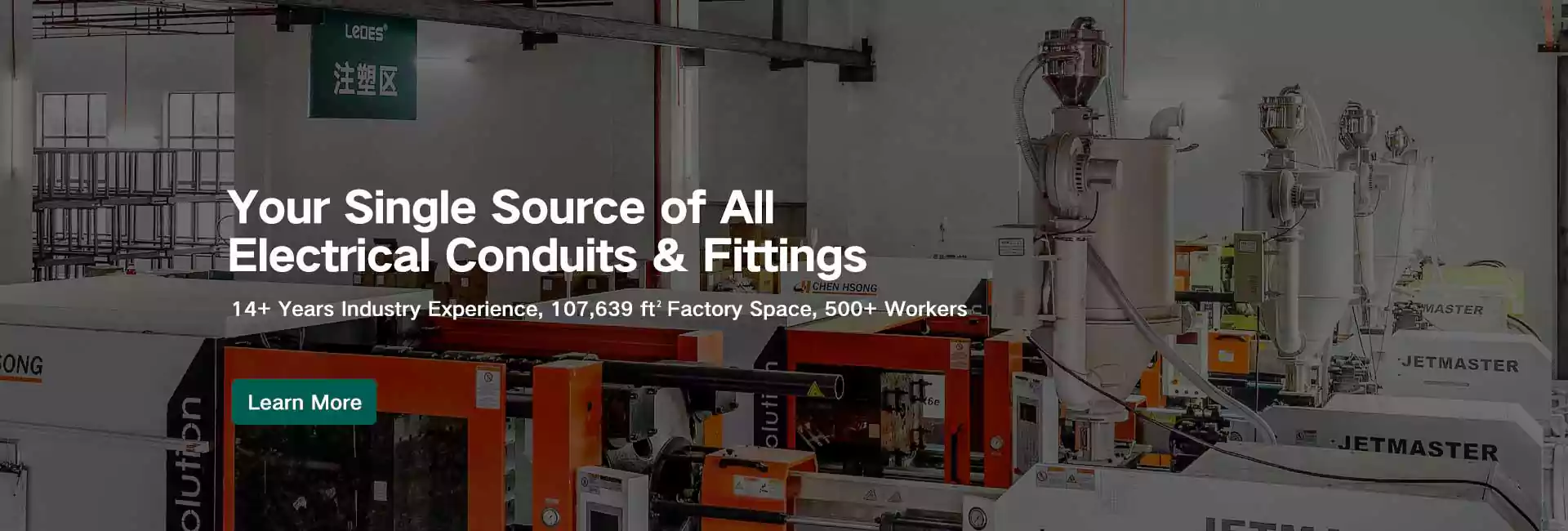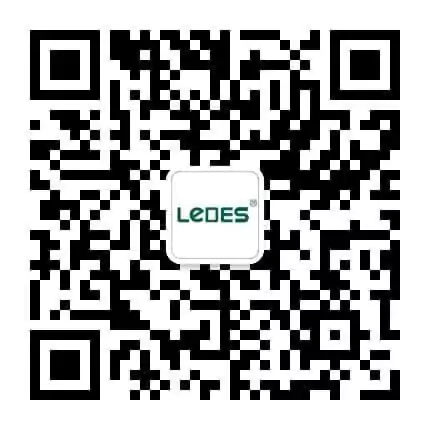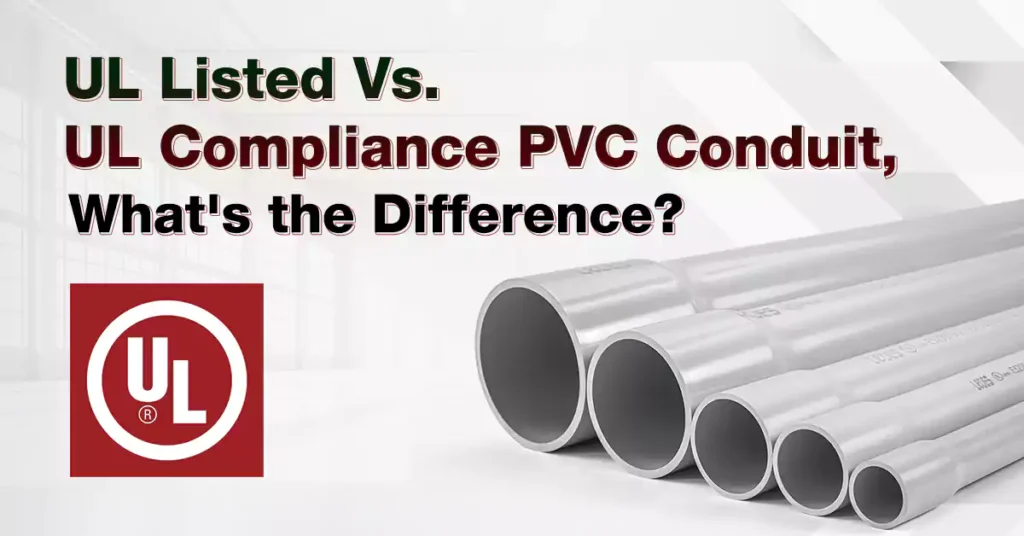
Tabla de contenido
When it comes to purchasing electrical products, consumers often find reassurance in certification marks from trusted third-party organizations. However, the true meaning behind these marks is not always clear, and many manufacturers are left wondering whether they need to pursue such certifications for their products. If you’re uncertain about whether your PVC conduit requires UL certification, you’re not alone.
UL, or Underwriters Laboratories, is an independent safety science organization that provides testing, inspection, and certification services to manufacturers across various industries. But UL certification isn’t a one-size-fits-all credential. There are multiple marks—such as UL Listed, UL Recognized, or UL Classified—that represent different levels of testing and compliance. Understanding these distinctions is essential for manufacturers who want to ensure they meet industry standards and regulatory requirements.
For many companies, the decision to pursue UL certification is a strategic one. While it involves a process that can be both time-consuming and costly, the safety benefits it offers to end-users, along with the assurance it provides to partners and regulators, can greatly enhance the credibility of your products. Prioritizing safety can also foster consumer trust and loyalty, which are critical factors in long-term business success.
In this article, we will explore the differences between UL Listed and UL Compliance PVC conduit, providing insight into what these terms mean and why it matters for manufacturers and consumers alike. Whether you’re navigating UL’s complex certification system or determining whether your product needs UL certification at all, understanding the ins and outs of UL marks will help you make more informed decisions.
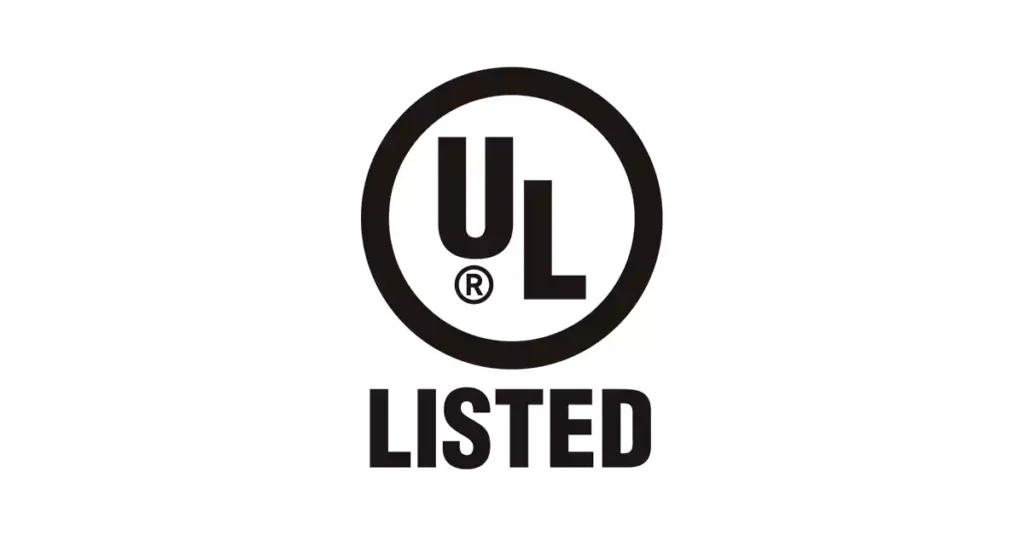
UL Listed PVC conduit refers to products that have been rigorously tested and certified by Underwriters Laboratories, an independent global safety science company. When a PVC conduit is UL Listed, it means that the product has met specific safety standards set by UL and has been approved for use in electrical installations. This certification is a mark of quality and safety, assuring customers that the product has undergone thorough testing for factors such as flame resistance, durability, and electrical insulation.
The process of becoming UL Listed involves submitting samples of the product to UL for testing. These tests are designed to evaluate the product’s performance under various conditions, ensuring that it meets the stringent requirements outlined in UL standards. Once a product passes these tests, it is added to UL’s database of certified products, and the manufacturer is authorized to use the UL Listed mark on their product packaging and marketing materials.
For PVC conduits, the relevant UL standard is UL 651, which specifies the requirements for Schedule 40 and Schedule 80 rigid PVC conduit and fittings. This standard covers aspects such as material composition, dimensions, markings, and performance under different environmental conditions. A UL Listed PVC conduit not only meets these standards but also provides peace of mind to contractors, engineers, and end-users who rely on the product’s safety and reliability.
Consejos: You can read our last post to explains UL 651 standard for PVC conduit.
UL Compliance refers to products that are designed to meet UL standards but have not undergone the formal certification process. In other words, a PVC conduit that is UL Compliant is manufactured in accordance with UL standards, but it has not been tested and certified by UL itself. This distinction is crucial because while UL Compliance indicates that a product is designed to meet certain safety standards, it does not carry the same level of assurance as a UL Listed product.
Manufacturers may claim UL Compliance for their products based on internal testing or third-party evaluations. However, without the formal UL certification, there is no independent verification of the product’s compliance with UL standards. This can lead to potential risks, as the product may not perform as expected in real-world conditions. For this reason, many buyers prefer UL Listed products, as they come with the assurance of independent testing and certification.
It’s important to note that UL Compliance is not a formal designation recognized by UL. Instead, it is a term used by manufacturers to indicate that their products are designed to meet UL standards. While this can be a useful indicator of quality, it should not be confused with UL Listed, which involves a more rigorous and independent certification process.
UL Certification is a comprehensive process that involves the evaluation of a product’s safety, performance, and compliance with specific standards. In the context of PVC electrical conduits, UL Certification is a mark of quality that assures customers that the product has been tested and approved by an independent third party. This certification is particularly important in industries where safety is paramount, such as electrical installations.
The UL Certification process begins with the submission of product samples to UL for testing. These tests are designed to evaluate the product’s performance under various conditions, including exposure to heat, flame, and mechanical stress. The product must meet the requirements outlined in the relevant UL standard, such as UL 651 for PVC conduits, to be eligible for certification.
Once a product passes the required tests, it is added to UL’s database of certified products, and the manufacturer is authorized to use the UL mark on their product packaging and marketing materials. This mark is recognized globally as a symbol of safety and quality, and it can provide a competitive advantage in markets where safety standards are strictly enforced.
In addition to product certification, UL also offers factory inspections and ongoing monitoring to ensure that certified products continue to meet UL standards. This ongoing oversight helps to maintain the integrity of the UL mark and provides additional assurance to customers that the products they are purchasing are safe and reliable.
The primary difference between UL Listed and UL Compliance lies in the level of assurance provided by each designation. UL Listed products have undergone rigorous testing and certification by UL, providing independent verification that the product meets specific safety standards. In contrast, UL Compliance indicates that a product is designed to meet UL standards but has not been formally certified by UL.
This distinction is important for several reasons. First, UL Listed products carry the UL mark, which is recognized globally as a symbol of safety and quality. This mark can provide a competitive advantage in markets where safety standards are strictly enforced. Second, UL Listed products have been independently tested and verified, providing a higher level of assurance to customers. Finally, UL Listed products are subject to ongoing monitoring and factory inspections, ensuring that they continue to meet UL standards over time.
In contrast, UL Compliance is a self-declared designation that does not involve independent testing or certification. While it can be a useful indicator of quality, it does not carry the same level of assurance as UL Listed. For this reason, many buyers prefer UL Listed products, particularly in industries where safety is a primary concern.
It’s also worth noting that some manufacturers may use the term “UL Certified” interchangeably with “UL Listed.” While both terms indicate that a product has been certified by UL, “UL Listed” is the more commonly used term in the context of PVC conduits and electrical fittings.
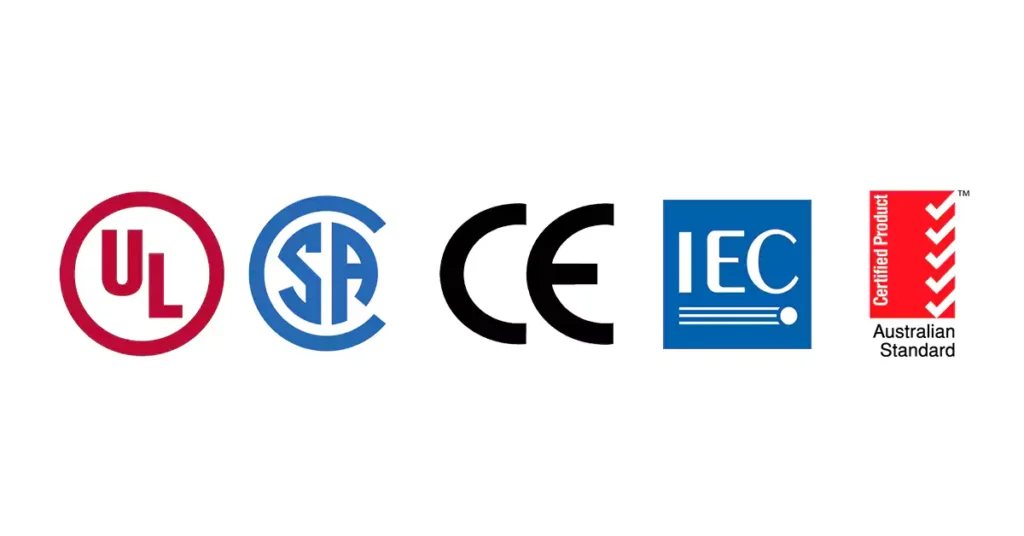
In addition to UL Certification, other certification marks are recognized in different regions. Each regions and countries have their own standards. For example:
Region: Primarily used in Canada.
Standards: CSA C22.2 No. 211 for PVC conduits.
Focus: Safety and compliance with Canadian electrical codes.
Process: Testing and factory inspections similar to UL.
Mark: CSA mark.
Consejos: Learn more about the CSA C22.2 standard for our last guide, ‘CSA C22.2 standard for DB2 conduit’.
Region: Required for products sold in the European Economic Area (EEA).
Standards: EN 61386 for conduit systems.
Focus: Compliance with EU health, safety, and environmental regulations.
Process: Self-declaration by the manufacturer, often supported by third-party testing.
Mark: CE mark.
Region: Recognized globally, particularly in Europe, Asia, and the Middle East.
Standards: IEC 61386 for conduit systems.
Focus: International standardization of electrical and electronic products.
Process: Testing and certification by accredited bodies.
Mark: No specific mark, but compliance is often indicated in product documentation.
Consejos: You can read our last post to learn all about IEC standard electrical conduit.
Region: Primarily used in Australia and New Zealand.
Standards: AS/NZS 2053 for PVC conduits.
Focus: Compliance with Australian electrical safety standards.
Process: Testing and certification by accredited bodies.
Mark: AS/NZS mark.
Consejos: If you are interested in details of AS/NZS 2053 standard, you can click the link to read our last post.
Aspecto | UL Certification | CSA Certification | CE Marking | IEC Standards | AS Certification |
Region | USA and globally | Canadá | European Economic Area (EEA) | Globally (especially Europe, Asia, Middle East) | Australia and New Zealand |
Estándares | UL 651 for PVC conduits | CSA C22.2 No. 211 for PVC conduits | EN 61386 for conduit systems | IEC 61386 for conduit systems | AS/NZS 2053 for PVC conduits |
Focus | Safety, performance, and fire resistance | Compliance with Canadian electrical codes | Health, safety, and environmental compliance | International standardization | Compliance with Australian electrical codes |
Testing Process | Rigorous testing by UL | Rigorous testing by CSA | Self-declaration (often with third-party testing) | Testing by accredited bodies | Testing by accredited bodies |
Mark | UL Listed, UL Certified | CSA mark | CE mark | No specific mark | AS/NZS mark |
Factory Inspections | Regular inspections | Regular inspections | Not required | Not required | Regular inspections |
Market Preference | Preferred in the USA and international markets | Preferred in Canada | Required in the EEA | Recognized globally | Required in Australia and New Zealand |
For manufacturers targeting multiple regions, obtaining the appropriate certifications is crucial. While the process can be time-consuming and costly, it ensures compliance with local regulations, enhances product credibility, and opens doors to new markets. By understanding the differences between these certifications, you can make informed decisions about which standards to pursue for your PVC electrical conduits.
UL Certification is not always legally required, but it is highly recommended, especially in markets where safety standards are strictly enforced. In the USA, for example, many local building codes and regulations require the use of UL Listed products for electrical installations. This is particularly true for PVC conduits, which are used to protect electrical wiring in residential, commercial, and industrial settings.
Even in regions where UL Certification is not mandatory, it can provide a significant competitive advantage. Customers, contractors, and engineers often prefer UL Listed products because they come with the assurance of independent testing and certification. This can help to build trust and credibility, which are essential for success in competitive markets.
While UL Certification is not a legal requirement for all products in the USA, it is often necessary for electrical products, including PVC conduits. Many local building codes and regulations require the use of UL Listed products for electrical installations. Additionally, retailers and distributors may require UL Certification as a condition for carrying a product.
For companies looking to enter the US market, obtaining UL Certification can be a critical step. It not only ensures compliance with local regulations but also helps to build trust with customers and partners. Without UL Certification, it may be difficult to compete in a market where safety and quality are top priorities.
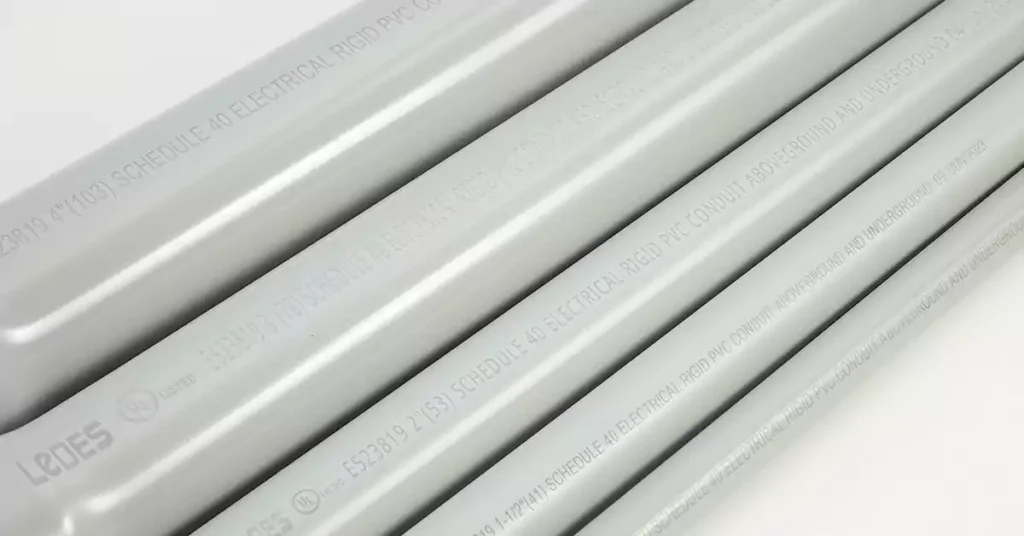
The need for UL Certification when importing products into the USA depends on the type of product and its intended use. For electrical products, including PVC conduits, UL Certification is often required to comply with local building codes and regulations. Additionally, customs authorities may require proof of certification before allowing certain products to enter the country.
Even if UL Certification is not strictly required, it can simplify the import process by demonstrating that the product meets recognized safety standards. This can help to avoid delays and ensure a smooth entry into the market.
UL Certification is a critical consideration for manufacturers, distributors, and end-users of electrical products, including PVC conduits. Its importance extends beyond mere compliance; it impacts safety, market access, and brand reputation. Below, we break down the key reasons why UL Certification is important, presented in a clear and structured format for better understanding.
UL Certification involves rigorous testing to ensure that products meet high safety standards.
For PVC conduits, this includes tests for flame resistance, impact resistance, and durability under various environmental conditions.
Certified products reduce the risk of fire, electrical shock, and other hazards, protecting both users and property.
In many regions, including the USA, UL Certification is often required by local building codes and regulations.
Using UL Listed products ensures compliance with these regulations, avoiding potential legal issues or project delays.
For example, UL 651 is the standard for PVC conduits in the USA, and adherence to this standard is often mandatory.
The UL mark is globally recognized as a symbol of quality and safety.
Contractors, engineers, and end-users are more likely to trust and choose products that carry the UL Listed mark.
This trust can lead to increased customer loyalty and repeat business.
UL Certification is often a prerequisite for selling products in key markets.
Retailers, distributors, and project specifiers may require UL Listed products as a condition for doing business.
Certification opens doors to new markets and opportunities, giving manufacturers a competitive edge.
UL Certification signals a commitment to quality and safety, enhancing a brand’s reputation in the industry.
It differentiates certified products from non-certified competitors, making them more attractive to buyers.
A strong reputation for safety and reliability can lead to long-term business success.
UL has developed a wide range of standards for electrical products, including PVC conduits and fittings. The most relevant standard for PVC conduits is UL 651, which specifies the requirements for Schedule 40 and Schedule 80 rigid PVC conduit and fittings. This standard covers aspects such as material composition, dimensions, markings, and performance under different environmental conditions.
Key Requirements of UL 651 for PVC Conduits
Requirement | Descripción |
Composición del material | The conduit must be made from PVC material that meets specific flame resistance and durability requirements. |
Dimensiones | The conduit must meet specific dimensional requirements, including wall thickness and outer diameter. |
Marcas | The conduit must be clearly marked with the manufacturer’s name, UL mark, and other relevant information. |
Flame Resistance | The conduit must pass flame resistance tests to ensure it does not contribute to the spread of fire. |
Resistencia al impacto | The conduit must withstand impact tests to ensure it can withstand physical damage during installation and use. |
Environmental Tests | The conduit must pass tests for exposure to sunlight, moisture, temperature and other environmental factors. |
To obtain UL Certification for PVC conduits, manufacturers must meet several requirements. These include submitting product samples for testing, providing detailed documentation, and undergoing factory inspections. The specific requirements may vary depending on the product and the applicable UL standard.
Steps to Obtain UL Certification
- Product Testing: Submit samples of the PVC conduit to UL for testing. The tests will evaluate the product’s performance under various conditions, including flame resistance, impact resistance, and environmental exposure.
- Documentación: Provide detailed documentation, including material specifications, manufacturing processes, and quality control procedures.
- Factory Inspection: UL will conduct an initial factory inspection to ensure that the manufacturing process meets UL standards.
- Ongoing Monitoring: After certification, UL will conduct regular factory inspections to ensure continued compliance with UL standards.
The cost of UL certification can vary widely depending on several factors:
- Type of product: The complexity of the testing required for PVC conduit, for instance, may involve specific environmental or electrical performance tests.
- Manufacturing scale: Larger operations with complex processes may incur higher costs for certification.
- Testing fees: Fees for testing, inspections, and follow-up evaluations can add up.
Generally, manufacturers should expect initial certification fees ranging from a few thousand to tens of thousands of dollars, with additional costs for periodic inspections
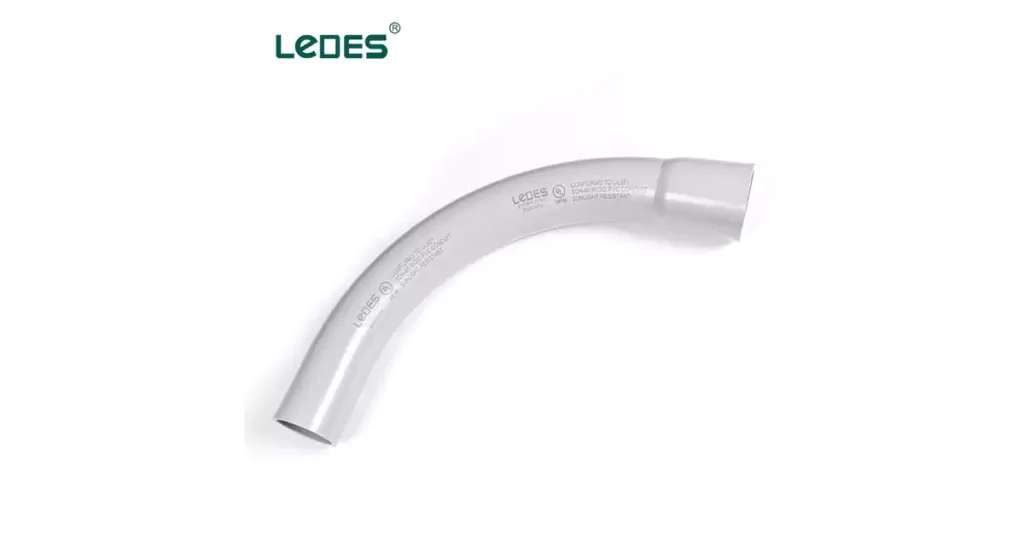
At Ledes, we pride ourselves on delivering high-quality, UL-certified PVC conduits and fittings that meet the highest standards of safety and performance. Our product range includes rigid PVC conduits, Electrical Nonmetallic Tubing (ENT), and a variety of fittings designed to meet the diverse needs of electrical installations. Below, we provide an overview of our products and the relevant UL standards they comply with, ensuring they meet the requirements of markets of North America.
Description: Our rigid PVC conduits are designed for durability and ease of installation, making them ideal for protecting electrical wiring in residential, commercial, and industrial applications.
Estándares:
UL 651: Specifies the requirements for Conducto Schedule 40 y Schedule 80 conduit and fittings like elbows in various angles (e.g., 90°, 45°) and couplings. This standard covers material composition, dimensions, flame resistance, impact resistance, and environmental performance.
Aplicaciones: Suitable for use in exposed and concealed installations, both indoors and outdoors.
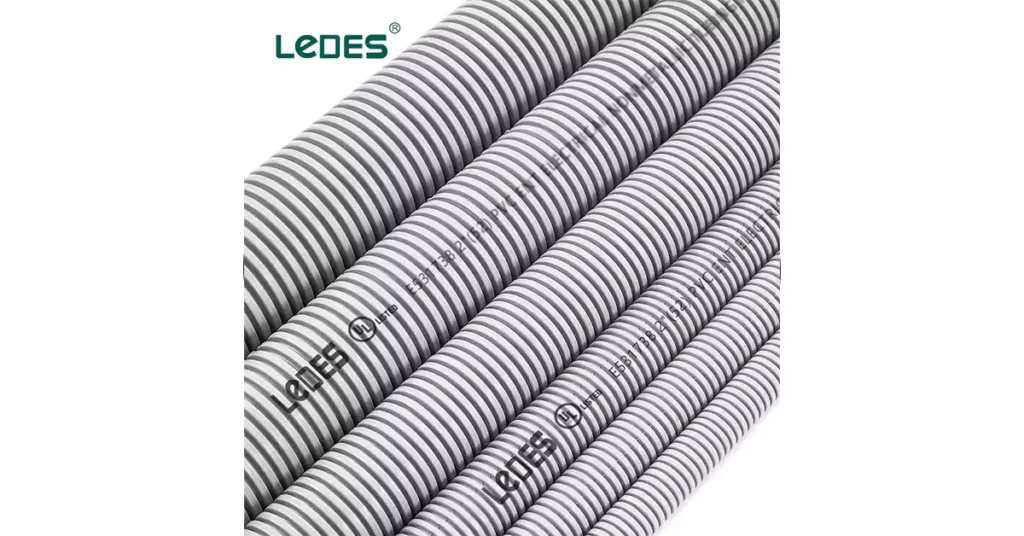
Description: Conducto de otorrinolaringología is a flexible, corrugated conduit that provides excellent protection for electrical wiring in applications where flexibility is required.
Estándares:
UL 1653: Covers the requirements for Electrical Nonmetallic Tubing, including flame resistance, crush resistance, and flexibility.
Aplicaciones: Ideal for use in walls, ceilings, and floors where bending around obstacles is necessary.
Our comprehensive range of accesorios de conductos ensures secure and reliable connections for PVC conduits and ENT. These include :
Adapters
Gang Boxes
Wall Boxes
Conduit Bodies
Ceiling Boxes
Standard:
UL 514C: Specifies the requirements for conduit fittings, including material composition, mechanical strength, and flame resistance.
UL Certification: All our products are UL Listed, ensuring they meet the highest safety and performance standards.
Comprehensive Range: From rigid conduits to flexible ENT and a wide variety of fittings, we offer solutions for every application.
Global Compliance: Our products comply with key international standards, making them suitable for markets worldwide.
Seguro de calidad: Rigorous testing and ongoing monitoring ensure that our products consistently meet customer expectations.
Edificios residenciales: Safe and reliable electrical installations in homes and apartments.
Commercial Spaces: Durable conduits and fittings for offices, retail stores, and other commercial properties.
Industrial Facilities: Robust solutions for protecting electrical wiring in demanding industrial environments.
Instalaciones exteriores: Weather-resistant conduits and fittings for outdoor electrical systems.
Ledes is committed to providing high-quality, UL-certified PVC conduits and fittings that meet the needs of modern electrical installations. Whether you require rigid PVC conduits, flexible ENT, or a variety of fittings, our products are designed to deliver safety, reliability, and performance. By adhering to UL standards such as UL 651, UL 1653, and UL 514C, we ensure that our solutions meet the highest industry requirements.
Understanding the differences between UL Listed and UL Compliance PVC conduits is essential for making informed decisions in the electrical conduit industry. While UL Compliance indicates that a product is designed to meet UL standards, UL Listed products provide the assurance of independent testing and certification. For companies operating in markets like the USA, Canada, Australia, and the Middle East, UL Certification is a critical factor in ensuring compliance with local regulations and building trust with customers.
At Ledes, we are committed to providing high-quality UL Listed PVC conduits and fittings that meet the highest standards of safety and reliability. Contact us today to learn more about our products and how we can help you meet your electrical conduit needs.
For more information about UL Listed PVC conduits and fittings, or to request a quote, contact Ledes today. Our team of experts is ready to assist you with all your electrical conduit needs.

